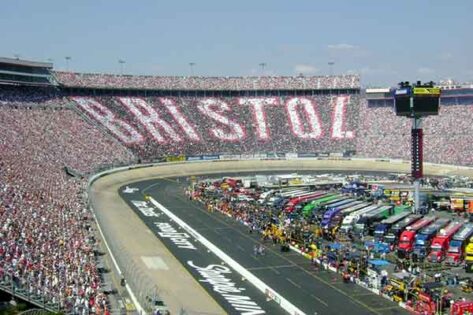The ancient Romans knew how to party in their colosseums, with gladiators fighting for glory, and heroes of the ancient world were born. If we swap out the gladiators and lions for roaring engines and thunderous cheers, right in the hills of Tennessee, you’ve got something NASCAR fans call home. Bristol Motor Speedway isn’t just another short track. The energy? Unmatched. The atmosphere? Electric. And the battles? Downright gladiatorial.
There’s a reason why Bristol earned the dramatic nickname “The Last Great Colosseum.” It’s not just about the size or the noise. Rather, it’s something deeper, something baked into the concrete and chaos of every race night. So, what exactly makes Bristol deserve that title? Let’s get into it.
How Bristol Motor Speedway’s design earned it the title ‘The Last Great Colosseum’
Bristol Motor Speedway’s architecture is the key to its legendary status as “The Last Great Colosseum.” The track is a short, 0.533-mile oval featuring extremely steep banking, up to 28-30 degrees in the turns, that allows cars to race at blistering speeds despite the tight layout. This steep banking creates a bowl-like effect when combined with the fully enclosed grandstands that surround the entire track, forming an amphitheater-like stadium.
Architecturally and experientially, Bristol’s bowl-like design means every spin, crash, and pass feels monumental, just as gladiatorial battles were at ancient colosseums. This physical enclosure symbolizes the brutal, survival-of-the-fittest style of racing the track is famous for, making the nickname both a nod to history and a fitting description of its role as a modern battleground for racing glory.
The loudest track in NASCAR: Why Bristol echoes like a modern-day colosseum
If you’ve never been to Bristol Motor Speedway, you might not understand what loud means. The moment engines fire up inside the tight, high-banked half-mile, it’s like unleashing thunder in a tin can, and there’s nowhere for the sound to escape. What makes Bristol Motor Speedway the loudest track in NASCAR isn’t just the raw power of the stock cars. It’s the architecture.
Bristol is one of the few tracks where grandstands completely encircle the racing surface, creating a true stadium-style bowl. That enclosed design traps the sound and reflects it into the stands, amplifying every throttle, gear change, and collision to a bone-rattling level.
Combine that with seating for over 150,000 fans (many of whom are on their feet screaming during the final laps), and the result is a deafening, visceral experience unlike any other in motorsports. According to a study by the National Institute for Occupational Safety and Health, the noise at Bristol has been measured at over 140 decibels, equivalent to a jet engine at just 100 feet away.
That’s why so many fans and drivers call Bristol a “colosseum.” Just like the Roman amphitheaters of old, it’s a place where roars echo off stone (or in this case, concrete), and chaos unfolds for the crowd’s delight. It’s not just racing, it’s sonic warfare. Bring earplugs.
Gladiator-style battles: How Bristol became known for the most intense NASCAR showdowns
The nickname also references Bristol’s reputation for gladiator-style racing. Close, aggressive, and often brutal on-track battles. The tight confines of the half-mile track, combined with its steep banking and short straightaways, turn every position into a hard-fought duel. Drivers regularly employ the “bump-and-run” tactic, nudging opponents just enough to clear a path without spinning out, a racing style that echoes the intense physicality of ancient gladiator combat.
Two of the most famous bump-and-run moments at Bristol Motor Speedway perfectly capture the track’s gladiatorial spirit. In the 1999 Bristol Night Race, Dale Earnhardt executed a now-legendary bump-and-run on Terry Labonte in the closing laps. As Earnhardt later said, he didn’t mean to wreck Labonte but just to “rattle his cage,” sending Labonte spinning out and sealing a dramatic victory for Earnhardt.
Another iconic instance was the 1997 Food City 500 spring race when Jeff Gordon used the bump-and-run on Rusty Wallace in the final laps to wrest the win from the longtime Bristol stalwart. The intense rivalry and heated post-race moments from this battle remain etched in fans’ memories as a quintessential Bristol moment. Fast forward to the 2002 Sharpie 500 Night Race, when Gordon again used the maneuver to edge out Wallace.
With just three laps remaining, Gordon bumped him out of the way to claim victory. Another legendary Bristol moment. These examples show how bumper contact at Bristol is more than just racing. It’s strategic, emotional, and often decisive, embodying the intense, physical battle that earns the track its “Last Great Colosseum” reputation.
Wrapping up
Bristol Motor Speedway is more than just a racetrack. It’s a spectacle, a colosseum where modern-day gladiators trade paint under the lights. From its amphitheater-like design and deafening acoustics to the fierce, no-holds-barred racing that defines its legacy, Bristol delivers an experience that’s as primal as it is thrilling. Every bump, roar, and cheer adds to the legend. Whether you’re a lifelong NASCAR fan or a first-time visitor, one thing is certain. When the green flag drops at Bristol, you’re witnessing a battle worthy of the title “The Last Great Colosseum.”
The post Why Is Bristol Motor Speedway Called the Last Great Colosseum? appeared first on EssentiallySports.
